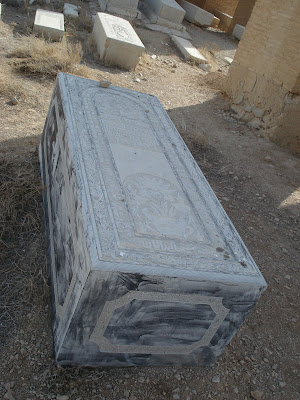Pir Bakran

Si-o-Seh Pol at night in Esfahan is really a beauty. But if Venus, the crescent of the moon, and mercury are illuminating the scenery, it's just amazing. You have to click on the picture and carefully examine the inflated image to see Mercury in the center of the right side in the sky. I could watch the rapidly moving innermost planet on several evenings when recently visiting Iran.
One obligation of my trip was to visit again the Jewish cemetery in Esfahan's vicinity. The 2000 years old site is difficult to find. At least on my map of Iran Linjan is not explicitly mentioned. Go to the southwest, the taxi driver will most probably know. In Linjan, which is a larger town, you should ask for the Jewish cemetery. We called a local by mobile phone who immediately showed and turned out to be a Muslim (!) guide of the site. He was a friend of the Jews in the town, he told us. I remembered last year's visit. The narrow room again showed recently burnt candles.





Our guide immediately mentioned the tomb of Sarah, daughter of Asher, son of the Patriarch Jacob (Genesis 46: 17; Numbers 26: 46; I Chronicles 7:30). The shrine was a major pilgrimage site for Iranian Jews. According to a midrash, Sarah never died. A popular tradition among Iranian Jews held that she arrived in Esfahan with the exiled Jews from the tribe of Judah. Miraculous stories and pious legends surrounding this figure were common in Jewish circles. See more information here. The same dog as last year was keeping watch in the courtyard of the small synagoge. Jews have not an easy life in Iran. I met many Muslims this time who consider them as good people. In Esfahan, they have some shops in Khiaban Chahar Bagh and close to the Meydan-e Shah. They themselves see their situation more critical. There seems to be a constant suspicion of Zionism. Jews (not more than 25'000 have stayed), who are said to have built Esfahan after having been freed from the Babylonian Captivity by Cyrus the Great in 539 BCE, live a secret life in Iran. I have not made serious attempts to visit the main, rather hidden, synagoge in Esfahan, which is close to the Enqelab-e Eslami Square (the point, where the first picture was taken).




























Comments